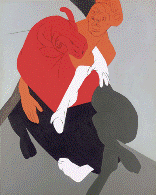 As confidence for Indian modern art returns, prices will rise in the same proportion as they did in the last decade.
As confidence for Indian modern art returns, prices will rise in the same proportion as they did in the last decade.
What are we to make of the sale of just two artworks at auctions this year equalling the size of the entire Indian market?
Pablo Picasso's Nude, Green Leaves and Bust last week became the world's highest-priced artwork when it was auctioned by Christie's for Rs 478 crore (Rs 4.78 billion), beating Alberto Giacometti's sculpture Walking Man I that was auctioned earlier in the year by Sotheby's for Rs 468 crore (Rs 4.68 billion).
That the Indian art market is terribly undervalued hardly needs reiterating. But when it fell from Rs 1,500 crore (Rs 15 billion) in 2008 to about Rs 800-900 crore (Rs 8-9 billion) currently, the signals it sent out were not just about the low value attached to Indian artists but, more importantly, about the shortage of good art in the market.
In part, this is because what we refer to as "modern art" has had a very short history in India, with even fewer artists working in that style. How many of Raja Ravi Varma's co-painters can we name?
Or, for that matter, who were Amrita Sher-Gil's contemporaries? Because "studios" hired painters to paint in the style that was then fashionable, works by even talented artists were attributed to an ambiguous "Anonymous" identity. Almost no research has been undertaken to identify who these artists were.
Since the forties, we have seen more works by more artists, but as compared to Western countries, the numbers have been low (because there were fewer patrons, perhaps - the "modern school did not appeal to everyone in India nurtured on a tradition of more sentimental aesthetics), and recognition for them even lower.
A number of artists who worked through the fifties, sixties and seventies would have remained for all purposes unknown, had not the heady pursuit of scarce artworks and a booming art market in the last decade led to their resurrection from a state of near-anonymity.
High disposable incomes, the opening of Indian markets and an appreciation of things Indian drove up the prices of Indian art on a combination of availability, quality and hype. Hysteria marked the new benchmarks that auctions now created.
The first painting to cross the Rs 1 crore (Rs 10 million) standard and each successive crore were excitedly reported and an increasing number of artists were welcomed to the "crore club". For a while it appeared that art for art's sake had been overtaken by art for investment's sake.
How the art market would have continued if it hadn't been reined in by recession is now in the domain of speculation. But this much we do recognise: that the art market had over-heated not because of the top prices paid to a few, rare quality artworks but because the vast and greedy contemporary market had been consumed by a lust for easy money.
Unproven artists were demanding and getting unreasonable valuations, mediocre art was over-priced, and there seemed no precedents any more to valuations.
But a thumbs-up to its recovery comes from art market research firm Art Tactic's report that shows confidence in the Indian modern art going up 28 per cent since October 2009. On its scale of one to 10, Indian modern art is now placed at 6.9, not just its highest ever posted by the London-based firm, but up from 4.9 just six months earlier.
The report is bound to bring speculators back into the Indian art market, lured by the prices and high confidence in, particularly, modern art - the gap between modern and contemporary art, according to the report, has widened to 51 per cent.
But some common sense should help the collector in arriving at the "right" price. If we accept that for a country of India's size, there were very few painters to begin with, and then accept the global average that only 10 per cent of an artist's work can be considered of exceptional quality, then the amount of such art is very limited and getting scarcer as it ends up in the hands of intuitions, or collections, that are unlikely to re-sell.
And it is works of such quality that will do for prices in the new decade what they did in the last decade, something that investors with their short-term concerns would do well not to overlook.
India's highest prices for art were achieved in 2008, true, but this must be said: in the decade 2001 to 2010, the highest prices achieved moved from Rs 10 lakh to well above Rs 10 crore (Rs 100 million).
In the coming decade, the same quality of artworks will see the price move from Rs 10 crore to - yes, hold your breath! - Rs 100 crore (Rs 1 billion).
Even at that price, a Tyeb Mehta or F N Souza, an S H Raza or M F Husain will still be a fourth or fifth of Picasso's current value, but we can save the catching up for the next decade that will follow.
These views are personal and do not reflect those of the organisation with which the writer is associated.






